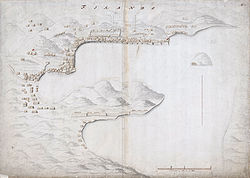This article has multiple issues. Please help improve it or discuss these issues on the talk page . (Learn how and when to remove these messages)
|

VOC chief traders in Japan were the opperhoofden of the Dutch East India Company (Dutch : Vereenigde Oostindische Compagnie; VOC) in Japan during the Edo period, when Japan was ruled by the Tokugawa shogunate.
Contents
- Trading posts
- Hirado, 1609–1639
- Dejima, 1639–1860
- List of chief traders at Hirado
- List of chief traders at Dejima
- See also
- References
- Sources
- Further reading
- Sources and external links
The Dutch word opperhoofd (pl. opperhoofden, lit. 'supreme head[man]'), in its historical usage, is a gubernatorial title, comparable to the English name chief factor . It was a name for the chief executive officer of a Dutch factory, in the sense of trading post led by a factor, i.e. agent. The Japanese called the Dutch chief factors kapitan (from Portuguese capitão).
The Dutch East India Company was established in 1602 by the States-General of the Netherlands to carry out colonial activities in Asia. The VOC enjoyed unique success in Japan, in part because of the ways in which the character and other qualities of its opperhoofden were perceived to differ from other competitors.





